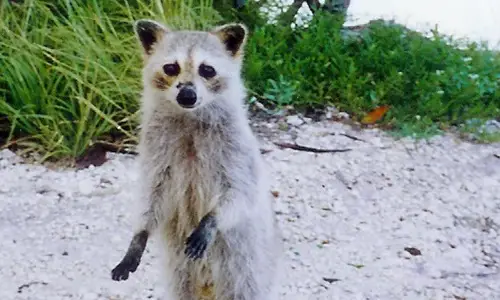Even if you haven’t seen one in real life, you must have seen a raccoon on TV or on Internet. These shrewd animals are set apart by the natural black mask they have around their eyes. Raccoons have bushy tails and their front paws are very human like.
Listed below are some interesting facts about these sturdily built, intelligent animals.
1) Size and Weight:
On an average, the adult raccoon ranges from 2 to 38 inches in length and has an average weight of 14 to 23 lbs. Male raccoons are larger than the female raccoons and are referred to as sow, whilst the baby raccoons are called kits.
2) Where to Find them:
Southern Canada and almost all parts of the United States have the highest number of raccoons. Woodlands are the most common and preferred habitats of raccoons. Howbeit, some species of raccoons are also found in urban areas as well as farmlands.
3) Food Preference:
Just like humans, raccoons are omnivores i.e. they can feed on both animals and plants. Raccoons can eat a wide variety of plant foods ranging from different types of nuts to various fruits like peaches, citrus fruits, figs, watermelons and plums. On top of that, raccoons can survive on insects, bird eggs, crayfish and frogs. Raccoons residing in urban areas usually survive on trash, due to the unavailability of their preferred food.
4) Sleeping and Social Patterns:
Raccoons are nocturnal animals and are seldom seen during daytime. They have powerful night vision. Raccoons prefer to live alone instead of living in the form of groups. However, the mother raccoon looks after her baby till the time he isn’t able to survive at its own.
5) Movement & Reproduction Patterns:
Raccoons move slowly, their walk is more like a shuffle. However, in some cases, they can walk as fast as 15 miles per hour on ground. Raccoons are exceptionally skilled climbers and swimmers and can sustain a drop of almost 35 feet from a tree. Raccoons climb trees swiftly.
The usual mating period for raccoons is the end of January or the beginning of February.
6)Average Lifespan:
On an average, Raccoons live to 16 years maximum. However, a captive raccoon lived up to 21 years. The lifespan of raccoons varies from habitat to habitat. The average lifespan of raccoons living in the wild is 5 years.
7) What Kills the Raccoons:
Raccoons often prey to coyotes, owls, cougars and bobcats. Raccoons usually face natural death at the hands of different diseases and infections like rabies and roundworm while raccoons residing in urban development’s often get hit by cars.
8) Hibernation Pattern:
During extreme winters, raccoons tend to sleep for long durations. This, however, is not similar to hibernation. Since raccoons reside in cold climates, raccoons combat with the cold by packing on extra layer of body fat before winters approach, in the fall season. This extra fat kicks in, in the form of energy, when raccoons cannot find food due to extreme cold.
9) Scientific Name and Taxonomy:
Procyon lotor is the scientific name of raccoon. It is neo-Latin and literally means before-dog washer.
Raccoons have been categorized into the Ursus genus by Carl Linnaeus. It was first known as Ursus cauda elongate which means long-tailed bear. Afterwards, it was classified as Ursus lotor which means washer bear.
10) Threat to Humans:
They maybe adorable at first, but they pose certain danger to humans because of their unpredictability. Adopting raccoons as pet animals can specially pose threat to children. Raccoons can attack you out of the blue.











Leave a Reply